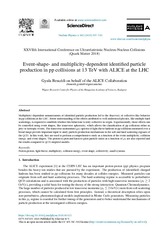Event-shape- and multiplicity-dependent identified particle production in pp collisions at 13 TeV with ALICE at the LHC
Bencédi, Gyula; Acharya, Shreyasi; Acosta, Fernando T.; Adamová, Dagmar; Adolfsson, Jonatan; Aggarwal, Madan M.; Aglieri Rinella, Gianluca; Agnello, Michelangelo; Agrawal, Neelima; Ahammed, Zubayer; Alme, Johan; Altenkaemper, Lucas; Djuvsland, Øystein; Ersdal, Magnus Rentsch; Fionda, Fiorella Maria Celeste; Nystrand, Joakim; Rehman, Attiq Ur; Røhrich, Dieter; Tambave, Ganesh Jagannath; Ullaland, Kjetil; Wagner, Boris; Zhou, Zhuo; Arsene, Ionut Cristian; Bätzing, Paul Christoph; Dordic, Olja; Lardeux, Antoine Xavier; Lindal, Svein; Mahmood, Sohail Musa; Malik, Qasim Waheed; Richter, Matthias; Røed, Ketil; Skaali, Toralf Bernhard; Tveter, Trine Spedstad; Wikne, Jon Christopher; Zhao, Chengxin; Hetland, Kristin Fanebust; Kileng, Bjarte; Nesbø, Simon Voigt; Storetvedt, Maksim Melnik; Helstrup, Håvard; Langøy, Rune; Lien, Jørgen André; Ahn, Sang Un; Aiola, Salvatore; Akindinov, Alexander; Al-Turany, Mohammad; Alam, Sk Noor; Albuquerque, D. S. D.; Aleksandrov, Dmitry; Alessandro, Bruno; ALICE, Collaboration
Peer reviewed, Journal article
Published version

Åpne
Permanent lenke
https://hdl.handle.net/1956/23248Utgivelsesdato
2019Metadata
Vis full innførselSamlinger
Originalversjon
https://doi.org/10.1016/j.nuclphysa.2018.08.021Sammendrag
Multiplicity-dependent measurements of identified particle production led to the discovery of collective-like behavior in pp collisions at the LHC. Better understanding of the effects attributed to well-understood physics, like multiple hard scatterings, is required to establish whether this behaviour is truly collective in origin. Experimentally, those effects can be controlled using event shapes, like transverse spherocity, which allows the classification of pp collisions either as jetty or isotropic events. The transverse momentum (pT) spectra of light-flavor hadrons in pp collisions measured over a broad range provide important input to study particle production mechanisms in the soft and hard scattering regimes of the QCD. In this work, they are used to perform a comprehensive study as a function of the event multiplicity, collision energy, and event shapes. The proton-to-pion and kaon-to-pion particle ratios as a function of pT are also reported and the results compared to QCD-inspired models.
